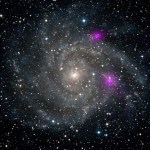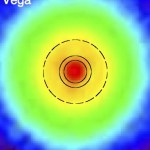astro
astropixie has running update on the Siding Spring Observatory Fire in Warrumbungle National Park in Australia.
PS: Day After the Fire update from astropixie - telescopes mostly ok, astronomy facilities not so much
#ClimateChange
Gemini AO LASER
As we come to the end of the 221st annual meeting of the American Astronomical Society, it is time to reflect upon the diverse science presented at the meeting.
And what a lot of science it was.
Fortunately, there were also a lot of people to make sense of it and press releases picked out for us to highlight that thought to be most likely to be of public interest.
Which is a good thing, partly because I was kept overly busy talking to prospie grads and assorted post-graduate job candidates.
I think I even got a chance to chat with some old friends, just to catch up.
Emily…
The AAS felt curiously light on major news this year.
Not that there weren't a lot of developments and announcements of results, rather that there didn't seem to any major obvious breakthroughs.
Of course, it is the little ones that get you...
Critically there is, of course, the annual, informal contest for the "best swag".
After the LSST pedometer in 2010 (back this year and still popular),
and the Ball Aerospace Alien Mobile in 2011 (also back this year),
I missed 2012 :-(
But, Duilia del Mello was there, and found the NASA ScreenClean (indispensable).
This year, well, we go with Duilia's…
The James Webb Space Telescope is large, overbudget and in a category of its own.
Literally.
And now stirring over some controversy as the reality of science funding starts smacking scientists in the face.
Last year, as I'm, sure you remember, the JWST funding line was take out of the Astrophysics Division and segregated in its own division, a funding maneuver that has been used before for large overruning projects.
This, incidentally, brutally exposed how tight the space science budgets have been squeezed, partly through overruns, partly through tough little missions hanging on longer than…
Space based infrared observations find double planetesimal belts around Vega.
Vega
Su et al. (ApJ in press) got Spitzer and Herschel observations of Vega, and find emission consistent with an inner warm asteroid belt and an outer cool planetesimal belt, with a gap between.
Vega
This is similar to what we see in the Solar System but on a bigger scale around a younger, hotter, more massive star.
The inference is that the gap between the two belts is kept clear of tepid dust by multiple planets orbiting in the region.
Schematic of Vega system inferred from observations
This is a very cool…
On the Blues and the Lifestyles and Fates of the Hottest Stars as they Cluster in the Heavens: or, why aging gracefully depends on your lifestyle and environment...
The Stellar Dynamical Clock
- is a Nature paper that came out in the Christmas double issue, always my favourite and very good value, might I add.
This paper is from a long term collaboration lead by Prof. Francesco Ferraro which over many cycles has built up a systematic sample of Hubble Space Telescope images of Galactic Globular Clusters, focusing, in partiular, on the blue and UV emitters in the dense cores of clusters, but…
It was at the gathering,
and all the astronomers were there,
drinking coffee among the posters,
hearing the NSF in despair...
I am at my almost regular pilgrimage to the Annual Meeting of the American Astronomical Society, where I hope to do some semi-liveblogging of developments and science news in my copious spare time.
I have more tasks than usual at this meeting, as not only am I, and my student, giving talks, I am also doing recruiting for prospective graduate students, postdoctoral hires and faculty, and attending the informal gathering of the ApJ editors.
I would also go to The Party,…
Hubble's Constant: H0 = 42!
42 scots miles/sec/Mpc that is.
Finally we know the natural units for cosmology.
The venerable Astrophysical Journal, Letters has a new editor: Prof. Fred Rasio.
Fred is the 4th editor in the journal's 45 year existence. The Letters are for the publication of rapid, short papers, which are timely, and often somewhat speculative.
Fred takes over from Chris Sneden, who did a fabulous job over the last decade, having replaced Alexander Dalgarno, who reigned over the Letters for three decades, having taken over from the first editor, Don Osterbrock when Don became Director of Lick Observatory.
Fred has published the traditional First Editorial - editorials by actual editors…
More Phenomenal random links to random stuff: life, the Universe and Everything
Phenomena - new blog group under National Geographic, including some long time scibloggers: The Loom, Not Exactly Rocket Science, Laelaps and Only Human, to begin with.
On the Usefulness of Useless Knowledge - Bee explains.
Substantive Advice to Admissions Committees - Or, why, all things being equal, we should prefer candidates from less prestigious institutions.
This is actually sensible - it is a "what have you done with what you were given" argument.
But, all things are very rarely equal... and no one ever…
Hey, Santa Baby!
Psy does it Christmas Style for Obama
wrapped up with Hark the Herald Angels sing with Diana Ross and Psy.
video at Grauniad
Power hath privilege indeed.
On the purity of science careers; the waste of civilization and other assorted snippets... and a happy Feast of St Nikolaus
The Rise of the Science Politician - Matt B. continues provocative Conversations.
There is an interesting thread on this on The Astronomers fb.
On The Inevitability of Kardashev Civilizations - the Astro Wright continues to lay the ground work for some fun speculation
Waste Heat: Parametrizing Alien Civilizations - the Astro Wright series continues with a reformulation of the Drake Equation appropriate to K3 civs.
What Do We Want Graduate School To Be? - astrobites…
MINERVA - clever idea for high cadence RV searches around nearby bright stars, now under way.
Kardashev IV - from AstroWright.
Or, why the best way to achieve immortality is to not die.
how to make your bike sound like a horse - Brilliant! #ObMontyPython! From From Trotify.
Physicists open mouth - PZ inserts booted foot
B on search for Planck scale physics on tabletops
The slightly more breathless view on the tabletop
Seeing the elephant - BaBar sees T violation. CPT rules!
Pontification on MOOCs
Astrobio MOOC (not for credit)
News Higgs results...
Death of SUSY?
Long live SUSYN!
Colossal…
In which we dunk and pie our professors...
Much has been written about student morale and the problems of student-faculty relations and the implicit expectations faculty have of the students.
Over the last couple of weeks I have had occasion to test some of the more radical proposals to improve the interactions of our students with the faculty.
It started two weeks ago last wednesday: we were summoned to the coffee room with the promise of sweets.
Instead we were faced with a bizarre array of students and staff dressed in native costumes who, after some tribal dancing and handing out of…
Visiting Astrobiology Chair in DC: research and engagement.
Applications and nominations are open for the Baruch S. Blumberg NASA/Library of Congress Chair in Astrobiology.
"Established in the Fall of 2011, the Blumberg Astrobiology Chair is a distinguished senior position at the Library’s Kluge Center.
The incumbent conducts research at the intersection between the science of astrobiology and its humanistic aspects, particularly its societal implications, using the collections and services of the Library. The incumbent is expected to be in residence at the Kluge Center for a period of up to…
Blows against supersymmetry and facebook.
Matthew Bailes continues ruminations at the Conversation - the general riff is on crowd sourcing and distributed computing, with a bit of bragging on The Beast they got down under.
Ok, I'm, just jealous.
I had not heard of Diaspora - be interesting to see if it can crowd out fb or other commercial social networks.
The Raspberry Pi I had indeed heard of, and will be acquisitioning. My kids are so looking forward to have their own computers... ;-)
But, what we really conclude, is that Matt needs to meet Charlie Stross for a quiet beer or three.
On a…
New faculty positions in multiple science and engineering disciplines, including astronomy, emphasizing computational analysis and data mining.
Penn State is embarking on a transformative cluster hiring initiative in cyberscience – computation- and data-enabled science and engineering – to lead through cyber-enabled innovation in interdisciplinary research. This cross-college endeavor will coordinate multiple faculty appointments to develop new functional capabilities centered on data, models and simulation for deeper insights into the critical problems in Science and Engineering.
We seek…
Schrödinger's Qu'ran - a 2012 thought experiment - in The Conversation, Matthew Bailes updates a classic paradox...
"...a physicist could extend this thought experiment to write a php script that would randomly download one of the Bible, Qur’an or even a classical quantum mechanics textbook to the iPad..."
On the Dispositive Null in the Literature - on an unrelated subject, the AstroWright expounds on a subtle issue.
Trendy Companions - more AstroWright
What do we want graduate school to be?
When do we want it?
Real Soon Now!
I will have a report on a definitive solution to the whole climate…
Given ηEarth=1
Find more terrestrial exoplanets.
Find habitable terrestrial exoplanets.
Find inhabited terrestrial exoplanets.
Go visit.
Consider the following snippets:
Kepler discover 5 planets orbiting inside 0.1 AU
Kepler: A Transiting Circumbinary Planet in a Quadruple Star System
Terrestrial mass planet discovered around α Cen B
Kepler exoplanet survey jeopardized
Kepler has lost one of its reaction wheels.
That was the spare, one more goes, and it will not complete its mission, it will not be able to stay pointed at its target.
Because of stellar jitter, the science goal for Kepler,…
α Centauri B, a mere 4 lightyears away has a terrestrial planet orbiting it.
α Cen B b
The most interesting aspect of the discovery may be the inferences we can make rather than the planet itself.
The discovery by the Geneva Observatory team using the
HARPS spectrograph is a wonderful example of precision high cadence spectroscopy and the ability of observers to find planets wherever they may be. The precision of the measurment is 0.5 m/sec, which is astonishing.
The discovery will be published in Nature (X. Dumusque et al. Nature 17 Oct 2012) thursday, and was due to be announced…



